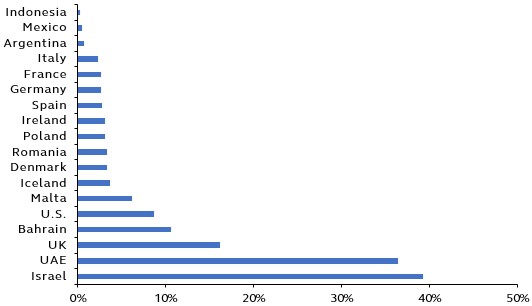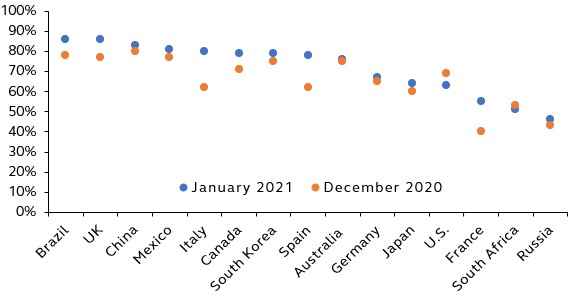Short and sharp: A healthy dose of scepticism
Aside from a short period of global market unrest triggered by meme stock trading, investor sentiment has remained broadly positive through the first few weeks of the year. This is despite the relentless spread of COVID-19 which, at the end of January, had infected more than 100 million people around the world—a 23% increase in just one month—and killed over two million. While their intentions are to keep economies open, governments have had no choice but to introduce strict restrictions on mobility in a bid to contain the spread.
With the advent of a series of successful vaccines, global markets can almost afford to be oblivious to virus headlines and instead focus on the medium-term when economies have reopened. But, against this backdrop, a big question for investors must be: how quickly can populations be vaccinated?
Share of people who received at least one dose of COVID-19 vaccine
Percent, February 2021
Source: Our World in Data, Principal Global Investors. Data as of February 5, 2021.
Despite having contracted for more than enough doses of the various vaccines to immunize most or all of their adult populations by the end of this year, most developed economies are falling behind with their vaccination schedules. In Israel and the UAE, almost 40% of their populations have received at least one vaccine dose. But they are the clear frontrunners. The U.S. and the UK are making strides, but are both less than a fifth vaccinated. Several European countries have vaccinated less than 3%, and many emerging countries are yet to even receive vaccines, let alone deploy them.
The challenges
Mass vaccination programs were always going to suffer teething troubles, with supply bottlenecks, logistical hurdles and mass manufacturing constraints the key issues.
1. Manufacturing
By the end of 2021, manufacturers forecast they will be producing at an annualized rate of 11 billion doses, more than double the global production of all vaccines in any prior year. While this is extremely promising news, until manufacturing hits its top speed, shortages of the vaccine will, unfortunately, be common.
This struggle has been very visible in the European Union where supply delays from both Pfizer and AstraZeneca descended into a blame game that pitted the EU against the pharmaceutical industry, triggering fears that countries could resort to vaccine nationalism.
In many emerging markets, the situation is even worse. Apart from Russia, China and India, which have their own vaccine pipelines, much of the emerging world has been unable to secure sizeable deals that will rapidly give them access to many of the successful vaccines. Indeed, sub-Saharan Africa—a population of more than a billion—has administered less than 100 doses in total.
2. Slow vaccine approval
Another reason behind the EU’s underperformance has been its slow vaccine approval. Whereas regulators in both the UK and the U.S. have granted emergency approvals, with the UK giving the green light to Pfizer as of December 3, 2020 and the U.S. doing so just a week later, the EU has been considerably slower. In fact, by the end of 2020, not one vaccine had been approved for use in the EU.
3. Distribution
Distribution has also been stunted due to country-specific logistical issues, ranging from bureaucratic inefficiencies to subdued vaccine acceptance rates. In recent surveys, France has stood out for its low COVID vaccine acceptancy, with only around half of the population willing to take the vaccine compared to over 80% in Brazil and China, and a 70% global average. This reluctance is in line with France’s general approach to vaccines and it’s been little surprise that France has had one of the slowest rollouts of all the European economies.
Don’t be too disheartened
Even for countries that are doing relatively well in their vaccination programs, the timeline for achieving herd immunity is extended. For example, in the U.S. at the current rate of 1.3 million doses per day, it will take almost seven months to get one dose to 80% of the U.S. population (262 million people), and over a year to get both doses to that 80%.
Importantly, however, most of the problems that have weighed on the vaccine rollout can be overcome. Pharmaceutical companies are likely to hit their production stride within months, mitigating shortages. In addition, governments are smoothing out their inefficiencies and dedicating greater resources to the roll-out process, in recognition of the fact that the speed at which economies can vaccinate their populations will be vital to allowing them to fully reopen.
In the U.S., President Biden has pledged to administer 1.5 million vaccines a day—hopefully bringing forward the date the U.S. will reach herd immunity. In the UK, where a more contagious COVID variant is wreaking havoc, the government is prioritising the first dose and delaying the second dose, in hopes of vaccinating as many people as quickly as possible. Even in France, their complicated and lengthy procedures have been reviewed and dedicated vaccination centres have been set up, accelerating the daily vaccination rate in just the last week.
COVID-19 vaccine acceptance
Percentage of respondents willing to take vaccine, by country

Source: Ipsos: “Global Attitudes on a COVID-19 Vaccine”, Principal Global Investors. Data as of January 17, 2021. Numbers above represent the percent of respondents in each country who responded to the question ‘If a vaccine for COVID-19 were available, I would get it.’
What’s more, the latest surveys suggest that acceptancy rates have shown a remarkable increase over the last month. Acceptancy rates have only fallen in South Africa (likely due to concerns over vaccine efficacy against the South African COVID variant) and in the U.S. which had seen a steep increase in acceptancy the previous month. We expect further rises on the back of evidence of strong efficacy and safety news, while continued social restrictions will no doubt convince greater numbers of people that taking a vaccine is the quickest way back to normality.
Economic recovery on its way (hopefully)
The disappointing start to vaccination campaigns should, therefore, be followed by a rapid gearing up in the spring. Large shares of vulnerable populations in developed markets should receive their first dose by the end of Q1. Therefore, while the delayed rollout will lead to slightly lower Q1 GDP growth, this should be offset by stronger growth in Q2.
One headwind to consider is the risk of virus mutations. The South African, Brazilian and UK variants have caused considerable global anxiety about additional strains of COVID-19. As a result, it seems likely that countries will be more reserved about lifting restrictions than they would otherwise have been, particularly in relation to international borders. Specifically, developed countries may extend and deepen restrictions against visitor entry from countries that are behind with their vaccine schedule, posing a particular risk to the growth outlook for emerging markets.
Investment implications
With the Q1 downturn likely to be deeper, the global economy clearly needs continued policy support. Without it, just the prospects for a vaccine alone will not be enough to carry markets through the next few months. Global central banks remain committed to providing ample liquidity and stimulus, but there is some variation in the magnitude of fiscal responses in 2021. The U.S. is likely to add additional fiscal stimulus over the coming months, while Europe is set to pull back slightly. As such, U.S. markets look likely to outperform those in Europe.
Continued monetary stimulus and bursts of fiscal support maintain a strong foundation for risk assets, compensating for the slower than expected vaccine rollout. With that in mind, the cyclical trade should perform well, although the high human to human contact sectors, such as leisure and hospitality, will continue to face constraints for several more months.
Sustained outperformance from big tech is likely. The work from home trade is still very much in play, and it is becoming increasingly apparent that households and companies’ reliance on technology will not reverse course from here. Companies that have successfully used technology to pivot their business models during the pandemic have discovered new efficiencies that will support them from here forward.
2021 may turn out to be a tougher year than many of us envisaged. Re-opening economies will be a gradual process and countries will move at different speeds, inevitably influenced by the emergence of new variants and a greater understanding of the vaccines. But importantly for investors—and as markets have already recognised—it’s a question of when, not if.
Not already a Livewire member?
Sign up today to get free access to investment ideas and strategies from Australia’s leading investors.

